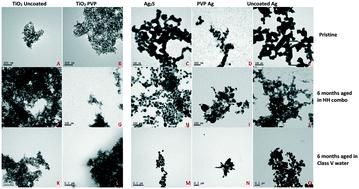当前位置:
X-MOL 学术
›
Environ. Sci.: Nano
›
论文详情
Our official English website, www.x-mol.net, welcomes your feedback! (Note: you will need to create a separate account there.)
Exposure medium and particle ageing moderate the toxicological effects of nanomaterials to Daphnia magna over multiple generations: a case for standard test review?
Environmental Science: Nano ( IF 7.3 ) Pub Date : 2020-03-20 , DOI: 10.1039/d0en00049c Laura-Jayne A. Ellis 1, 2, 3, 4 , Eugenia Valsami-Jones 1, 2, 3, 4 , Iseult Lynch 1, 2, 3, 4
Environmental Science: Nano ( IF 7.3 ) Pub Date : 2020-03-20 , DOI: 10.1039/d0en00049c Laura-Jayne A. Ellis 1, 2, 3, 4 , Eugenia Valsami-Jones 1, 2, 3, 4 , Iseult Lynch 1, 2, 3, 4
Affiliation

|
Pristine engineered nanomaterials (NMs) entering the aquatic environment become ‘aged’ during their lifetime via chemical, physical and/or biological process. Therefore, traditional ecotoxicology tests which were designed for soluble chemicals prior to the emergence of NMs, use pristine NMs and salt-only media which are not representative of realistic NM exposure scenarios. Exposure medium and NM ageing moderation of NM toxicity were explored using Daphnia magna multigenerational studies aiming to determine whether the daphnids adapted to continuous exposure and/or if parent-only exposure resulted in epigenetic effects in subsequent generations. Daphnids were continuously, or parent-only, exposed to pristine and aged titanium dioxide (TiO2) and silver (Ag) NMs, in a standard high hardness culture media and synthetic European Class V lowland water. Pristine NMs in the standard culture medium had the most severe toxic consequences, and displayed negative effects in two generations post exposure. NMs aged in the class V water had fewer overall toxic consequences on growth and longevity across all generations in both continuous and parent-only exposure scenarios. Overall, in the absence of environmentally relevant media and aged NMs, standardised Daphnia tests currently overestimate NM toxicity, and fail to consider potential impacts in subsequent generations. The results demonstrate the importance of updating standard testing to reflect scientific advances and increase stakeholder trust in regulation.
中文翻译:

暴露介质和颗粒老化可缓解纳米材料多代对大型蚤的毒理作用:是否需要标准测试?
进入水生环境的原始工程纳米材料(NMs)在其生命周期中通过化学,物理和/或生物过程变得“老化” 。因此,在NMs出现之前针对可溶性化学物质设计的传统生态毒理学测试使用的是原始NMs和仅含盐的介质,它们不能代表现实的NM暴露场景。使用大型蚤(Daphnia magna)多代研究探索了暴露介质和NM衰老对NM毒性的抑制作用,旨在确定蚤是否适合连续暴露和/或单亲暴露是否导致后代的表观遗传效应。大型水蚤一直或仅在母体中暴露于原始和老化的二氧化钛(TiO 2)和银(Ag)NMs,在标准的高硬度培养基和合成的欧洲V级低地水中进行。标准培养基中的原始NM具有最严重的毒性作用,并且在暴露后的两代中显示出负面影响。在连续和仅父母接触的情况下,在V级水中老化的NM对所有代的生长和寿命造成的总体毒性影响较小。总体而言,在没有环境相关介质和老化的NMs的情况下,标准化的水蚤测试目前高估了NM的毒性,并且没有考虑对后代的潜在影响。结果表明更新标准测试以反映科学进步并增加利益相关者对法规的信任的重要性。
更新日期:2020-04-24
中文翻译:

暴露介质和颗粒老化可缓解纳米材料多代对大型蚤的毒理作用:是否需要标准测试?
进入水生环境的原始工程纳米材料(NMs)在其生命周期中通过化学,物理和/或生物过程变得“老化” 。因此,在NMs出现之前针对可溶性化学物质设计的传统生态毒理学测试使用的是原始NMs和仅含盐的介质,它们不能代表现实的NM暴露场景。使用大型蚤(Daphnia magna)多代研究探索了暴露介质和NM衰老对NM毒性的抑制作用,旨在确定蚤是否适合连续暴露和/或单亲暴露是否导致后代的表观遗传效应。大型水蚤一直或仅在母体中暴露于原始和老化的二氧化钛(TiO 2)和银(Ag)NMs,在标准的高硬度培养基和合成的欧洲V级低地水中进行。标准培养基中的原始NM具有最严重的毒性作用,并且在暴露后的两代中显示出负面影响。在连续和仅父母接触的情况下,在V级水中老化的NM对所有代的生长和寿命造成的总体毒性影响较小。总体而言,在没有环境相关介质和老化的NMs的情况下,标准化的水蚤测试目前高估了NM的毒性,并且没有考虑对后代的潜在影响。结果表明更新标准测试以反映科学进步并增加利益相关者对法规的信任的重要性。

























 京公网安备 11010802027423号
京公网安备 11010802027423号